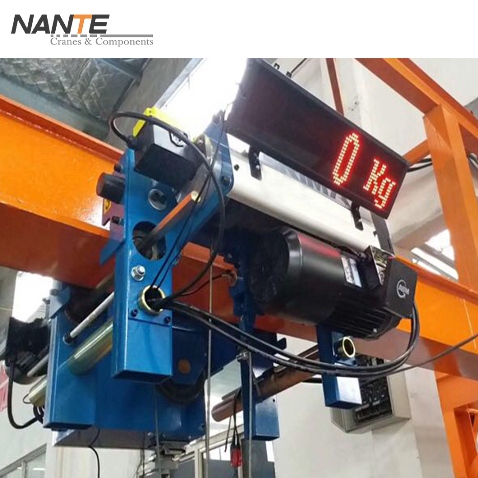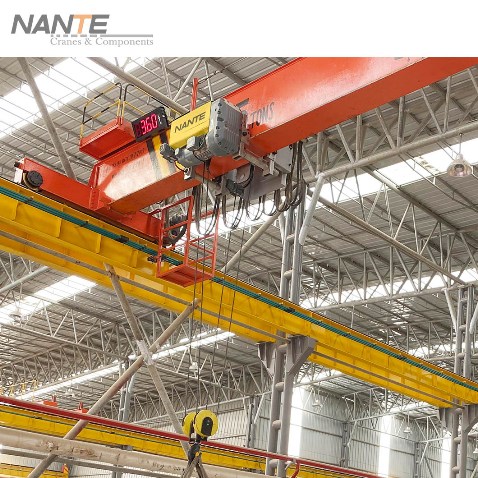Safety Device Used to Ensure the Safe Operation of Cranes
Date: 2024-02-26 Share:
Explanation of crane safety device

Overload Limiter
An overload limiter is used to monitor the load on a crane and is used to prevent the crane from exceeding the maximum load allowed by design. In addition, an overload limiter usually works by detecting the loaded weight of the crane via a sensor. Once it detects that the preset safe load has been exceeded, the overload limiter cuts off the power to the hoisting mechanism and may trigger an alarm, thus preventing the crane from overloaded working.
Load Weight Displayer
The load weight displayer is used to display in actual time the weight currently being carried by the crane. The display is able to keep the operator informed of the current load by receiving signals from the load cell and converting the weight data into a readable digital or graphical interface.
Position Limit Switch
Position limit switches are used to limit the range of motion of a crane in certain directions to prevent it from exceeding a predetermined safety zone. Position Limit Switch is usually installed on the crane’s rail or structure, when the crane reaches the set limit position, the switch will be triggered to cut off the power supply of the corresponding movement mechanism, so that the crane stops moving to ensure the purpose of safety.
Cross Limit Switch
Cross limit switch is used to ensure that the crane will not exceed the predetermined safety range during traveling. The specific working principle is that when the crane travels to the set limit position, the cross limit switch will be activated to cut off the power supply of the corresponding mechanism, preventing the crane from continued movement.
Photoelectric Sensor
Photoelectric sensors are used to detect objects or people around the crane to prevent collisions. Photoelectric sensors detect the presence of objects by emitting and receiving infrared or visible light. When an object is detected, the sensor sends a signal to the control system to take appropriate safety measures such as slowing down or stopping.
Crane Alarm
A crane alarm is used to warn of abnormal conditions or safety violations. When overloading, exceeding the range of motion or other unsafe conditions occur, the alarm system will be triggered to emit sound or light signals to alert the operator and surrounding personnel.
LED Lights
The LED light provides illumination at night or in low light conditions, ensuring that the operator has a clear view of the crane and its surroundings. It provides a high level of illumination by converting electrical energy into light energy. On cranes, LED lights are often installed in critical areas such as the hook and cab to improve operator visibility and safety.
These safety devices are an important part of the crane and they work in tandem with each other to ensure safe crane operation and reduce the risk of accidents. When using cranes, operators should familiarize themselves with their working principles and operation, and perform regular maintenance and inspections to ensure they work properly.
Application of crane safety device
Crane safety devices can be applied to various parts of the crane, hoist, end carriage and control panel. The following is an explanation of their application in each part:

Crane
On a crane, these safety devices serve to ensure safety and stability throughout the lifting process. Overload limiters, load weight indicators and position limit switches ensure that the crane is not overloaded or exceeds its operating range. Photoelectric sensors and crane alarms can be used to detect obstacles or people in the vicinity and warn or take emergency action if necessary, while LED lights provide the necessary illumination so that the operator can clearly see the crane and the surrounding environment.
Hoist
The hoist is an essential part of the crane for vertical lifting loads. Overload limiters and load weight indicators are particularly important here as they prevent the hoist from being overloaded, thus avoiding mechanical failure or accidents. Position limit switches and travel limit switches ensure that the hoist does not exceed its safety limits during lifting.
End Carriage
The end carriage is an important structural part of the crane, supporting the crane’s track and traveling mechanism. The main role of the safety device here is to ensure the stability and safety of the end carriage. Photoelectric sensors detect obstacles or people around the end carriage to prevent collisions, while LEDs provide illumination to help the operator see the end carriage and its surroundings clearly at night or in low-light conditions.
Control Panel
The control panel is the control center of the crane and is responsible for monitoring and controlling the functions of the crane. Here, the safety device serves to ensure the accuracy and safety of the control process. Load weight indicator and control logic can display real-time load data and operating status on the control panel to help the operator make correct decisions. A crane alarm system, on the other hand, can warn the operator of an abnormal situation and alert him to take emergency action. In addition, the control panel itself should be designed with an emergency power-off switch so that the power supply can be cut off quickly in case of emergency to prevent accidents.
In short, the importance of crane safety devices should not be overlooked. We learn from the above that crane safety devices can not only prevent overloading, increasing efficiency and utilization, but also improve, and reduce the potential for worker engagement and reaction accidental losses, increasing operational efficiency, besides, these safety devices can enable cranes to be installed and operated in accordance with regulations and standards. This information is important in maintaining worker safety, maintaining equipment integrity and ensuring the proper functioning of lifting equipment.
 English
English






